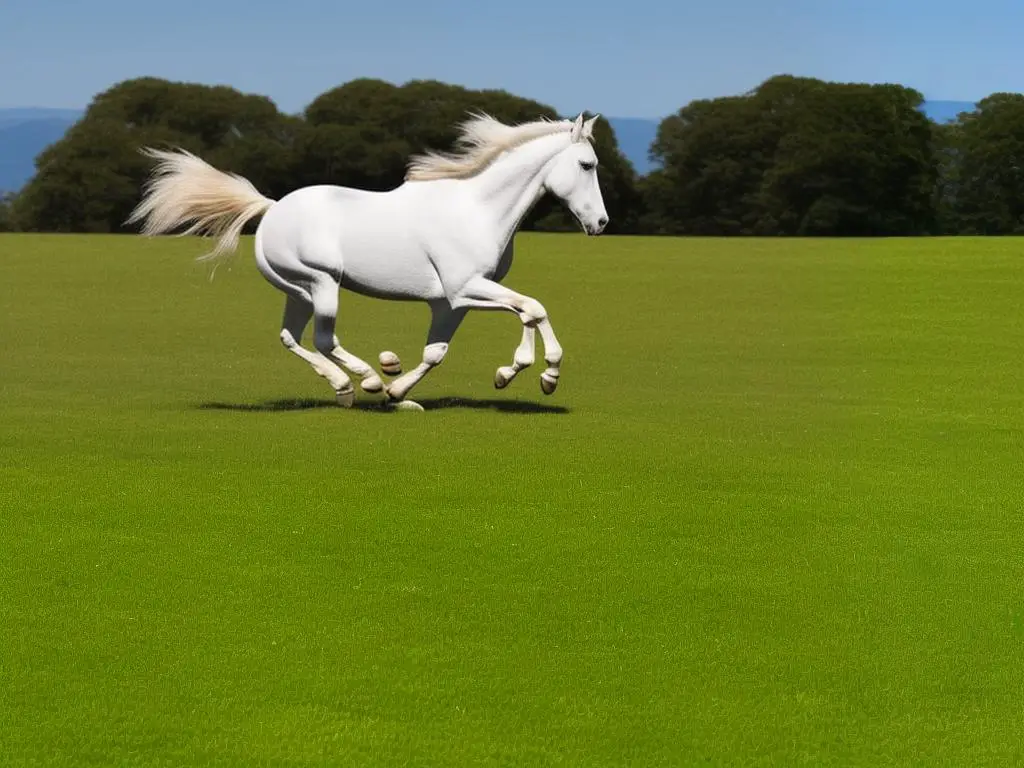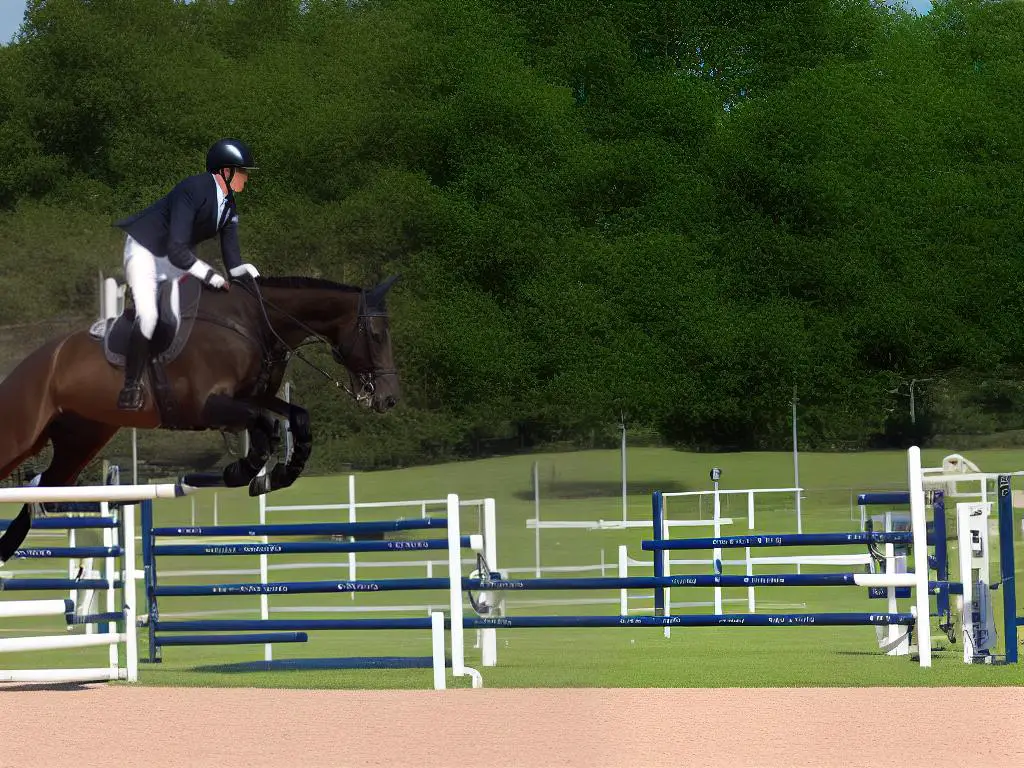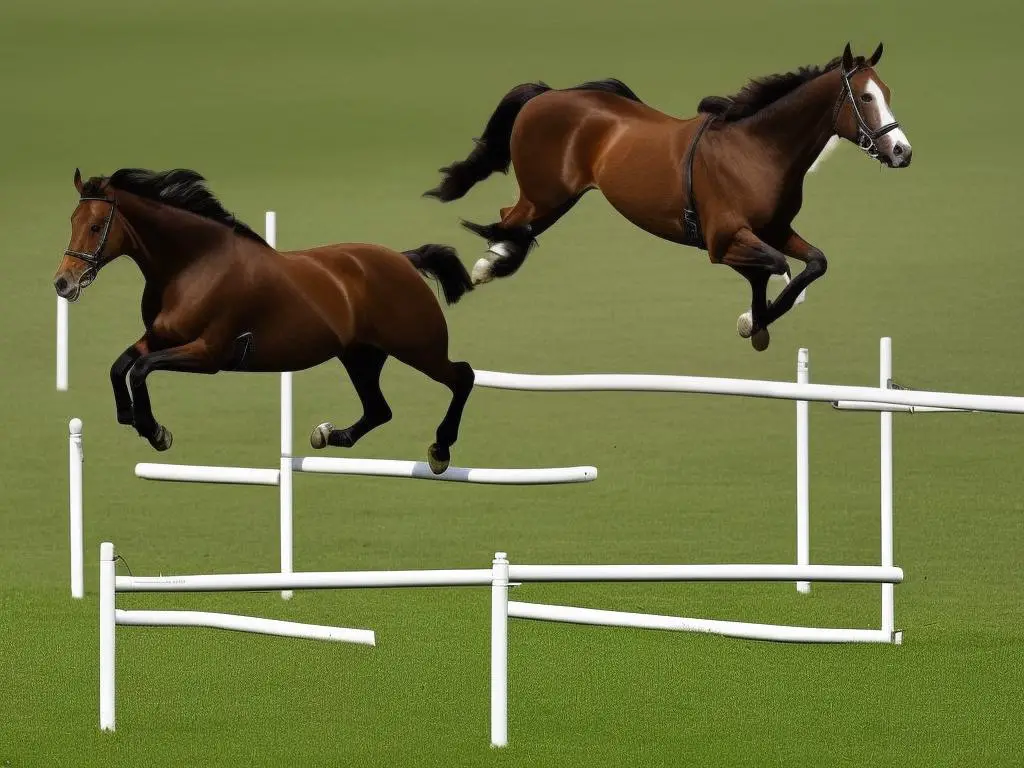German Warmbloods are the paragon of equine athleticism, with a rich history and an impressive reputation in the world of competitive equestrian jumping. Originating from selective breeding techniques that focused on endurance, agility, and unwavering power, these remarkable horses have cemented their place in the annals of jumping sport across the globe. In this comprehensive insight into German Warmblood jumping horses, we’ll explore their storied past, characteristic traits that set them apart, the training and care regimen that aids in honing their abilities, and the exceptional horses that have left indelible footprints in the equestrian realm. Additionally, we will provide pertinent information to guide you through the intricate process of acquiring a German Warmblood for jumping.
Table of Contents (Horspedia)
History and Origin of German Warmblood Jumping Horses
A Rich History: German Warmblood Jumping Horses.
Germany, a country with a long and rich history of horse breeding, is renowned for producing some of the world’s top warmblood horses – particularly in the discipline of show jumping. This equestrian excellence is rooted in a history that stretches back many hundreds of years.
The origins of today’s German warmbloods trace back to the Middle Ages when Teutonic knights bred hardy, solid horses able to carry a heavily armored rider into battle. As warfare changed and heavy cavalry became obsolete, these substantial horses were then bred for agriculture and transportation purposes.
Selective and Purposeful Breeding: The Rise of Warmblood Jumpers.
By the 19th century, European breeders began shifting their focus towards producing sport horses using these native agricultural breeds. In Germany, several regional breeding societies emerged, each producing their own type of warmblood horse. These included the Hanoverian, the Holsteiner, the Trakehner, and the Oldenburg among others.
While these specialized horses differed slightly in characteristics based on local demand and preference, they were collectively recognized as distinct German Warmblood varieties. Breeders meticulously recorded bloodlines and implemented strict selection and breeding standards.
This purposeful, selective breeding, combined with German riding schools’ strong tradition of equitation and training, resulted in the emergence of these distinct German Warmbloods as champions in international show jumping, dressage, and eventing competitions, particularly during the mid-20th century.
Characteristics for Jumping Prowess: Why German Warmbloods Shine.
German Warmbloods were selectively bred for their harmonious build, size, athleticism, and stamina – key attributes for jumping horses. They were required to demonstrate strong performance capacity, excellent movement, and jumping ability to be included in studbooks, driving the evolution of these breeds towards superior athletic performers.
Their muscular build, powerful hindquarters, and well-set necks allow for the high degree of collection and explosiveness needed to excel in show jumping. Their temperament, often characterized as calm, intelligent, and willing, also contributes to their success in the jumper ring.
In the sport of show jumping, the German Warmblood has undoubtedly secured itself a distinct place. Its success in the field can largely be attributed to the highly detailed and methodical breeding strategies that the German breeding societies have followed through history. Additionally, a focused training regimen as well as distinctive physical attributes that aid in enhancing the horse’s agility and power in show jumping, add to their strength. The result – an equine legacy that blends noble lineage, superior sporting talent and hundreds of years of history.
Image: Brown Horse Jumping During Daytime by Nicholas Githiri from Pexels
Characteristics and Traits of German Warmblood Jumping Horses
Key Physical Characteristics of German Warmblood Jumping Horses
German Warmblood horses, specifically those trained for jumping, have a robust and muscular build, with each individual breed showcasing tailored traits desirable in a jumper. A majority of German Warmbloods range from 15.2 to 17.2 hands in height, providing an optimal balance of size leading to strength and flexibility. Another characteristic feature of Warmblood is their sturdy hooves and legs, durable enough to bear high-impact landings. Importantly, compared to many other breeds, their skeletons are denser and more substantial, enabling them to carry greater weight and withstand the physical strain associated with show jumping.
Despite their muscularity, these horses are not excessively bulky to impede their performance. They possess a sleek body structure that aids in their speed and agility. The head, well-defined and expressive, enhances the visual appeal of this revered breed.
Temperament and Interactivity of German Warmblood Jumping Horses
A crucial part of what makes the German Warmbloods great jumping horses is their temperament. They are known to be highly trainable, with an aptitude for following commands and understanding cues. These horses are cooperative and have a strong desire to please their riders, making the process of conditioning easier.
Their temperament also leans towards bravery, making them more likely to fearlessly approach jumps. They possess a calm and balanced nature, which is beneficial in high-pressure competitive situations. Despite their vigor and energy, they can be easily managed and don’t typically spook easily.
The Power and Agility of German Warmblood Jumping Horses
The German Warmbloods are built for power. Their hindquarters are strong and packed with thick muscles, providing the driving force for powerful jumps. This power does not detract from their ability to gracefully manage the landing and quickly prepare for the next jump.
They have exceptional agility, which is a critical trait for maneuvering jumps and performing tight turns in a course. These horses are often bred especially for sports like jumping, leading to generations of horses with the physical capabilities and characteristics that make them exceptional athletes.
Understanding the Essence of German Warmblood Jumping Horses
German Warmblood Jumping Horses, through generations of selective breeding, have cultivated an inherent affinity for jumping. These horses naturally possess not only the desire to leap but also the physical prowess to do so efficiently.
With their impressive blend of strength, agility, and speed, German Warmbloods manage to deliver a seamless riding experience. Their penchant for jumping, coupled with their commendable temperament and high levels of trainability, have made them the preferred choice amongst numerous equestrian sports devotees.
The combination of physical prowess, exemplary temperament, and inherent agility have catapulted German Warmbloods to being one of the most coveted breeds for international show jumping. Owing to their potent mix of control and power, it looks certain that they maintain their stronghold in the world of competitive jumping.

Training and Care of German Warmblood Jumping Horses
Diving Deeper: An Overview of German Warmblood Jumping Horses
The German Warmbloods, originating in Germany, represent an esteemed selection of horse breeds. They have gained widespread acclaim for their astounding athletic capabilities, versatility, and, quite prominently, their exceptional skill in show jumping. In numerous international equestrian competitions, these linguist horses have garnered accolades, testifying to their extraordinary jumping abilities.
Specific Training Regimen
Training German Warmbloods for jumping demands a combination of precision, patience, and skill, both from the horse and its trainer. The training usually begins with basic groundwork, including walk, trot, and canter transitions under saddle. Over time, pole work is introduced to build the horse’s strength and familiarity with foot placement related to jumping.
Eventually, these horses are introduced to small jumps, which they negotiate with precision and grace. The height and complexity of the jumps are gradually increased as the horse grows in capability and strength. A critical aspect of training these horses is maintaining their interest and willingness to work. Trainers often introduce variety in the training regimen, such as cross-country rides and dressage training, to avoid monotony and to continue to challenge these intelligent equines.
Dietary Needs
German warmbloods, as high-performance athletes, require finely tuned diets. These horses typically need a diet rich in quality hay or pasture, grains, and a balance of vitamins and minerals. Given their athleticism, these horses usually require more energy-dense foods than their leisurely counterparts. The diet’s energy content usually increases as training intensifies and decreases during periods of rest.
Health Management
Maintaining the health of German warmblood jumping horses involves regular veterinary check-ups, vaccinations, farrier work, and dental care. These horses ought to be monitored closely for signs of stress or injury, as they can be more susceptible due to the demands of their training and performance.
Joint health is of special concern in these jumping horses owing to the large amount of stress placed on their legs and joints. Regular assessments can catch issues early before they become severe. Proper hoof care is also essential as unhealthy hooves can lead to discomfort and performance issues.
Importance of Rest and Mental Health
Just like with human athletes, adequate rest and mental health are crucial for these equine athletes too. Horses need periods of downtime where they can relax and rejuvenate. Regular breaks also prevent burnout and physical overstrain. It’s also necessary to ensure the horses have a positive environment where they’re handled gently and encouraged to interact with other horses for their psychological wellbeing.
Delving into the realm of German warmblood jumping horses is an intricate yet fulfilling journey. These equine athletes of extraordinary caliber demand focused training, a nutritionally balanced diet, consistent health evaluations, and ample relaxation to peak performance. Adherence to these guidelines can not only secure the horse’s welfare and lifespan but also empower them to tap into their maximal potential in the fast-paced, adrenaline-fueled sport of show jumping.

Famous German Warmblood Jumping Horses and Their Achievements
The Unparalleled Prowess of German Warmblood Jumping Horses
Known as undisputed high-performers in global show jumping events, German warmblood horses have etched an indelible mark in the equestrian domain. Their enduring legacy is marked by unmatched athleticism, adaptability, and their hallmark trait – a natural aptitude for jumping.
Shutterfly: A German Warmblood Legend
A Hanoverian gelding born in 1993, Shutterfly is considered one of the most successful show jumping horses in history. Partnered with rider Meredith Michaels-Beerbaum, Shutterfly won multiple Grand Prix circuit competitions, including Aachen, Geneva, Calgary, and the World Cup finals in Las Vegas.
Shutterfly’s achievements extended to international events as well – they secured team gold and individual bronze at the 2006 World Equestrian Games, and won the individual European Championship in 2007. This legendary German warmblood retired in 2011 but his influence persists in contemporary show jumping.
Cumano: The Champion of Precision
Cumano was a remarkable Holsteiner jumping horse that thrived under the guidance of Belgian rider, Jos Lansink. Born in 1993, Cumano astounded audiences with his exceptional jumping style, marked by precision and control.
Cumano’s track record was adorned with several notable wins. His crowning achievement was taking home the gold medal at the 2006 World Equestrian Games in Aachen, Germany. Despite retiring in 2011 at the age of 18, Cumano’s influence remains vibrant in modern jumping horse breeding.
Hickstead: The Stallion with a Heart of Gold
Despite being a Dutch Warmblood, Hickstead was born in Germany in 1996. With Canadian rider Eric Lamaze, Hickstead became one of the most celebrated horses in show jumping history. The dynamic duo achieved notable victories at the 2008 Beijing Olympics (individual gold and team silver) and the 2007 Pan American Games (individual silver).
Sadly, Hickstead passed away in 2011 after a grand prix event, but this esteemed stallion’s legacy continues to inspire future breeders and equestrians.
The Influence on Breeding and Training
These German warmblood jumping celebrities have left an indelible mark in their category. They contribute significantly to the values of the modern warmblood breeding industry, providing desirable genetic material, along with the hope of replicating those attributes that made them so successful.
Their achievements also sparked changes in training methods, emphasizing consistent, long-term programs focused on enhancing a horse’s inherent abilities, underlines the significant role of training and management in consolidating a horse’s potential.
To sum up, German warmbloods such as Shutterfly, Cumano, and Hickstead have left an indelible mark on equestrian history. They’ve demonstrated repeatedly that they are among the most proficient jumping horses, influencing the evolution of the sport. Their impact echoes in current advancements in breeding, training, and competitive strategies.

Buying or Adopting a German Warmblood
Investment in German Warmbloods for Jumping
The German Warmblood breed is a valuable asset in the equine world, prized for its power, agility, and robust musculature. The price of these horses varies considerably, ranging from an initial investment of around $10,000 to over $150,000. This range is dictated by the horse’s age, its training and lineage, and performance history. Keep in mind, owning a horse means more than just purchase cost. Additional expenses one needs to consider include feeding, housing, healthcare, and training costs.
Proper Setup for a German Warmblood
Keeping a German Warmblood means you should have a suitable stable environment. These horses are athletic and require plenty of space for exercise. Provide a large, clean stall, and guarantee regular access to a paddock or pasture for free roaming. These horses are used to cooler climates, so if you live in a warmer area, ensure proper shade and water supply.
Potential Problems to Look Out For
When purchasing a German Warmblood, vetting is essential. Get a comprehensive health check from a trusted equine vet to ensure the horse is in good health. Be on the lookout for any potential genetic conditions such as chronic progressive lymphedema (CPL), which affects the lower legs.
Like other sport horse breeds, stress-related behavioral problems may also occur if they are overworked or housed in unsuitable environments. They typically need regular, structured conditioning and time for rest and relaxation.
Identifying a Good Breeder or Agency
A good breeder or agency is transparent about their horses. They should be able to provide detailed medical histories and be upfront about the horse’s temperament and abilities.
Top breeders usually have a long-standing reputation within the equestrian community. Research, ask for recommendations, and consider visiting in person before making a decision. Pay attention to the way they treat their horses and their overall facilities’ cleanliness and orderliness.
Finally, an ethical breeder does not rush a sale. They should allow ample time for potential buyers to interact with the horse, ask questions, and even have third-party evaluations.
Adopting a German Warmblood
Adopting a German Warmblood might be an alternative option that suits you. Various rescue organizations or shelters might have warmblood breeds available, especially older horses or those needing rehabilitation. These adoptions carry lower initial cost but may involve more extensive long-term care. Remember, every horse, adopted or bought, deserves proper care, love, and a lifetime commitment to their well-being.

Whether you’re a passionate equestrian enthusiast or someone drawn to the charm and athleticism of these magnificent animals, understanding the intricacies of German Warmblood jumping horses provides a profound appreciation for their worth in the equestrian world. From their captivating history, distinctive traits, meticulous training regimen, to renowned examples of their breed setting records, the comprehensive exploration paints a vivid picture of these exceptional equine athletes. Furthermore, the information on acquiring a German Warmblood brings you one step closer to experiencing the exceptional blend of grace, strength, and agility that make these horses contenders in global jumping stages.
